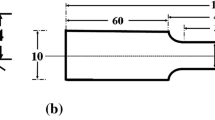Abstract
The residual stresses in a cylindrical weldment of HP-9-4-30 steel were measured with neutron diffraction in the as-welded (AW) state and after postweld heat treatment (PWHT). Large residual stresses are present in the interior of the material in the as-welded condition. The maximum principal stresses measured were found around the edges of the cap-pass heat-affected zone and reached up to 1045 MPa (76 pct of the base metal yield strength) in the as-welded condition. The principal stress directions for the residual stress tensors do not in general follow the hoop, axial, and radial axes of the weld and change from position to position within the weld, although the highest values are generally in the hoop direction. The postweld heat treatment relaxed the largest residual stresses, with the maximum value being 30 pct of the base metal yield stress. The need for position-dependent stress-free standards and the implications of stress gradients over the measurement volumes are discussed.
Similar content being viewed by others
References
A.D. Krawitz:Mater. Res. Soc. Symp. Proc., 1990, vol. 166, pp. 281–92.
I.C. Noyan and J.B. Cohen:Residual Stress: Measurement by Diffraction and Interpretation, Springer-Verlag, New York, NY, 1987.
R.A. Winholtz and J.B. Cohen:Aust. J. Phys., 1988, vol. 41, pp. 189–99.
M.J. Schmank and A.D. Krawitz:Metall. Trans. A, 1982, vol. 13A, pp. 1069–76.
M. Popovici, W.B. Yelon, R. Berliner, A.D. Stoica, I. Ionita, and R. Law:Nucl. Instrum. Methods A, 1994, vol. 338, pp. 99–110.
C.W. Tompson, D.F.R. Mildner, M. Mehregany, J. Sudol, R. Berliner, and W.B. Yelon:J. Appl. Crystalloys., 1984, vol. 17, pp. 385–94.
A.D. Krawitz, P.J. Rudnik, B.D. Butler, and J.B. Cohen:Adv. X-Ray Anal., 1986, vol. 29, pp. 163–71.
R.A. Winholtz and A.D. Krawitz:Adv. X-Ray Anal., 1994, vol. 37, pp. 253–64.
J. Hunt: Babcock & Wilcox, Mt. Vernon, IN, private communication, 1993.
I.C. Noyan:Metall. Trans. A, 1983, vol. 14A, pp. 1907–14.
D.A. Witte, R.A. Winholtz, and S.P. Neal:Adv. X-Ray Anal., 1994, vol. 37, pp. 265–78.
H.R. Wenk:Preferred Orientation in Deformed Metals and Rocks: An Introduction to Modem Texture Analysis, H.R. Wenk, ed., Academic Press, Orlando, FL, 1985, pp. 11–47.
Author information
Authors and Affiliations
Rights and permissions
About this article
Cite this article
Winholtz, R.A., Krawitz, A.D. The relaxation of residual stresses with postweld heat treatment in a high-performance weld measured with neutron diffraction. Metall Mater Trans A 26, 1287–1295 (1995). https://doi.org/10.1007/BF02670622
Received:
Issue Date:
DOI: https://doi.org/10.1007/BF02670622




